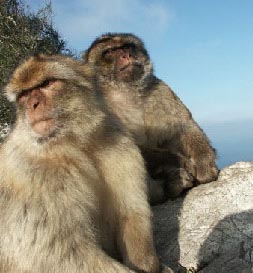 |
SOCIAL BEHAVIOR:
The barbary macaque has a multimale-multifemale social system, although unimale groups can occur. This species has a promiscuous mating system. Females remain in their natal group with the onset of maturity, but males will disperse shortly before adolescence. There is a hierarchical system amongst group members based upon the matriline. Males extensively take part in the caring of young which is unique among the macaques. Males will also care for young that are not their own. When the infants are able to move independently, the males will interact with them mostly carrying them around and grooming them (Taub, 1978; 1984). Males generally direct their caretaking towards one individual infant (MacRoberts, 1970; Taub, 1984). Mostly subadult males become caretakers, and because females mate with most of the males in the group (Taub, 1980) there is no reason to suspect paternity as why males take care of infants (Taub, 1984). |


